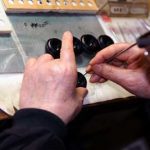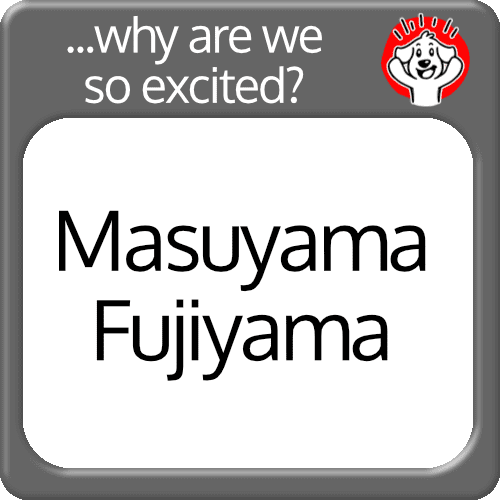[vc_row][vc_column][vc_column_text]In an eyepiece world that seems dominated by wide-view Televue and Baader, it is easy to miss Ohi Japan’s Fuyiyama and Masuyama eyepieces.
Fuyiyama
In the distant past, some ten years or more ago, the now famous Tani line of Orthoscopic eyepieces (Also known as “Circle-T”) were created by Mr Tani and assembled the eyepieces with Ohi glass (A bit like Germany’s Carl Zeiss Jena glass factory). This is a lovely bit of history, which would be sad to lose, so have a look at Mr. Tani’s work, which he started with five friends. Ohi rightfully became legendary due to the fine quality control and manufacturing processes that resulted in such excellent optics, much the same way CZJ became famed in Germany. University Optics, another excellent line of eyepieces, also used Tani lenses.


Very small parts are lined up.








So, what made Ohi such a standout? Ohi started up in may of 1951 and was closely associated with Nikon. In the 60’s, Ohi started to focus on instrument lenses and astronomical lenses.
What has this got to do with the Fuyiyama’s? Well, after turning 90 years of age, Mr Tani decided to retire and shut down. The eyepieces he created became legendary and are even now highly sought after, attracting fairly high prices on the used market. It seems that an era had ended. Additionally, companies such as Televue produced widefield eyepieces that started the trend to “go widefield”. After as while, people forgot all about Orthoscopic eyepieces, with all the excitement over Plossl’s… But then, the same classic design was revived so a new generation could experience it with the Fuyiyama line.
The entire Fujiyama lineup is parfocal (which means, as you swap eyepieces, you won’t need to refocus), accept standard 1.25″ filters, and comes with plastic eyepiece caps. The chrome barrels of the Fujiyama HD-ORs are straight up and down, and we have removed the often annoying, safety groove.
Solid construction, bright, clean and sharp views throughout a fully corrected 42 degree FOV, with sharp field stops, makes the Fujiyamas perfect for every type of viewing, and are also an excellent match with high end apochromats for hard core planetary, lunar, solar and double star viewing.
Masuyama
So, what has this got to do with Masuyama? Ohi is directed by a long line of Masuyama’s (1943 – Ichiharu Masuyama, 1952 – Haru Masuyama, 1976 – Ichiro Masuyama, 2011 – Shinji Masuyama, 2012 – Katsumi Masuyama. They started to make an excellent line of eyepieces known, unsurprisingly as the “Masuyama” eyepieces which developed an excellent reputation.
In 2016, Masuyama developed the latest incarnation by reviewing the lens design – the 85 degree Masuyama’s made with just 5 elements. They modestly describe the lens as “very good”. Is it? Well, the move to 85 degrees came at a price – This eyepiece needs to be mated with a long, slow refractor (f/10+, f/15 preferably, or something like an SCT (e.g. Edge HD) to work best. When done so, it is magnificent. So, I guess you need to ask yourself do I have that?
If not – you will get aberrations around the edges. Is that a write off for you? Perhaps. Perhaps not. Eyepieces have become so monocultural that “edge to edge” is almost expected. Baader reimagined their classic Ortho’s (which are always 42 degrees) to have a 52 degree field for “finding” so they have a very poor outer edge – and they are generally forgiven for that. If 25% of the edge of a Masuyama is poor, that makes it a superb 50 or 55 degree eyepiece with some space for “finding”. (Previous Masuyama’s were in fact 52 degrees). The other way to view this eyepiece, is as one that is suited for very slow scopes – at f/12, things become better, at f/15 and slower, these truly shine. Interestingly, according to William Paolini (an eyepiece critic), good positioning will get you more out of the eyepiece.
Supposing you do have the hardware it needs – what do you get? The eyepieces are feature a gorgeous Japanese build quality, they will keep a lifetime if well cared for. There is a small, dark exit pupil. It’s less expensive and less heavy compared to other 2″ “glass bombs”. They have nice, dark background sky, great neutral color saturation and comfortable views. Contrast and sharpness in the center are very good. It has very good Chromatic Aberration (CA) control. They are excellent for binoviewing. If double clusters get your heart racing, the eyepiece will stun you. The transparency is very good, so you can perceive stars you can’t otherwise.
Enjoy. The Fuyiyama’s and Masuyama’s are back!
[/vc_column_text][/vc_column][/vc_row]




